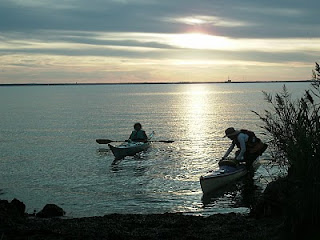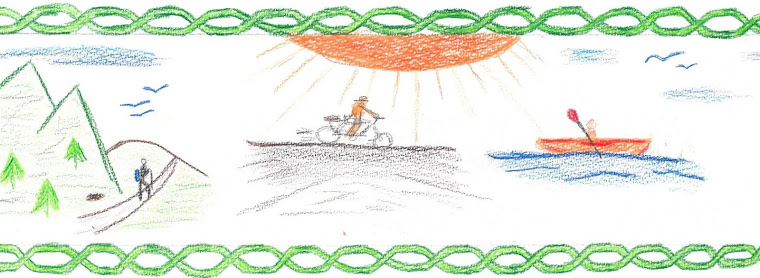 |
Barnegat Lighthouse as seen from the southern end
of Island Beach State Park |
Recently I was one of thirteen kayakers from the New York City metro area to paddle in New Jersey’s Barnegat Bay. Seven paddlers in seven boats were from the
Sebago Canoe Club, based in Brooklyn, and six paddlers in four boats were from the
Long Island City Community Boathouse, based in Queens.
The Long Island City paddlers were first to arrive at the Island Beach State Park kayak and canoe launch site and some of them were already in the water when my wife and I arrived. She and I had spent the night before with a friend on Long Beach Island and had driven an hour from the south to arrive at the site. The other five from Sebago, delayed due to 9/11 observance traffic and rerouting, arrived about an hour later than the 10:00 AM estimated arrival time.
The first challenge of our trip was route finding, which tested us before we ever unloaded our boats. I drove past the road to the launch site twice before we ventured down it on our third pass. With absolutely no signage and nothing but a dogleg hard right onto a sandy road on the bay side to suggest that the road was in fact the way to the put-in, we were not the only paddlers to miss the turn. After we unloaded our boats, I decided to drive back out to the road head to direct others yet to arrive to the put in.
We were all on the water by 11:20 AM. We paddled south out along the western side of the Sedge Islands to near the western end of Barnegat Inlet. With powerboats of all shapes and sizes zipping through the Barnegat Inlet channel as they were making their way between Barnegat Bay and the Atlantic Ocean, the channel crossing from north to south was one of the most challenging I have ever undertaken. Not only did we have to keep a careful watch out for boat traffic, we also had to contend with some large wakes from passing traffic. At one point it seemed a large power boat, running just north of the channel, was determined to run us down and passed by within only twenty or thirty yards.
Once across the channel we hugged the shoreline at High Bar until we beached on some sea grass, around 1:45 PM, within an easy walk of the Barnegat Light House. Walking toward the lighthouse, we made a beverage stop and those who did not bring lunch made a deli stop before we settled in at some picnic tables near the channel. After lunch, most of us walked to the lighthouse but not all who walked there climbed the 217 steps.
The view from the top outside platform of the Barnegat Light House was spectacular. The setting offered a commanding view of the southern end of Island Beach State Park, including where we had paddled from and what we hoped would be our return route. One could clearly the entire Barnegat Channel, including the rippling ebb current flowing out through it. The inhabited northern end of Long Beach Island offered a stark contrast to the uninhabited southern end of Island Beach State Park and one could see through the haze the outline of the larger casinos and hotels of Atlantic City, 50 miles to the south.
After a late lunch and playing tourist, we walked back to our kayaks, slipped into our cockpits, and around 3:50 PM started paddling back north. Crossing the channel from south to north was not nearly as hazardous as the earlier north to south crossing as it appeared most of the power boat traffic was now from Ocean to Bay rather than both ways, and not nearly as busy.
We discovered a breach in the Army Corps of Engineers Dike at the southern end of Island Beach that allowed us paddling access to to the Little Bay Trail without having to portage. As we paddled through the islands and salt marshes, however, some of us would occasionally encounter water so shallow that we had to exit our kayaks and drag them into deeper water until we could again paddle.
 |
Beaching at the Area 15 launch Site
at the end of the day and trip |
With the sun appearing ever closer to the western horizon, we debated whether to take out at the southern Area 21 access and hitch a ride to the cars at the northern access and to drive them south. We decided to keep paddling and easily made the northern access well before sunset, around 6:45 PM.
According to my GPS we paddled 9.5miles, 5 miles north to south and 4.5 miles south to north. One of the other Sebago paddlers on the trip, Ed, also had a GPS and logged a little over 10 miles. I can not explain the discrepency. Ed posted his GPS data, including a map of our paddle, on
the Garmin site.
This was my second Sebago trip involving a lighthouse, the first being over a year ago when we paddled from Long Island’s
Captree State Park to Fire Island and walked to the Fire Island Light House after beaching. Because we arrived too late that day to climb to the top of the Fire Island Light House, the Barnegat Light House is the first lighthouse I climbed while on a Sebago trip, and only the second lighthouse I have ever climbed, the other being the Montauk lighthouse.
On this Barnegat Bay trip, I was able to paddle one of my favorite club boats, a blue Necky Chatham 17, only occasionally using the skeg. I was not disappointed with the boat.







